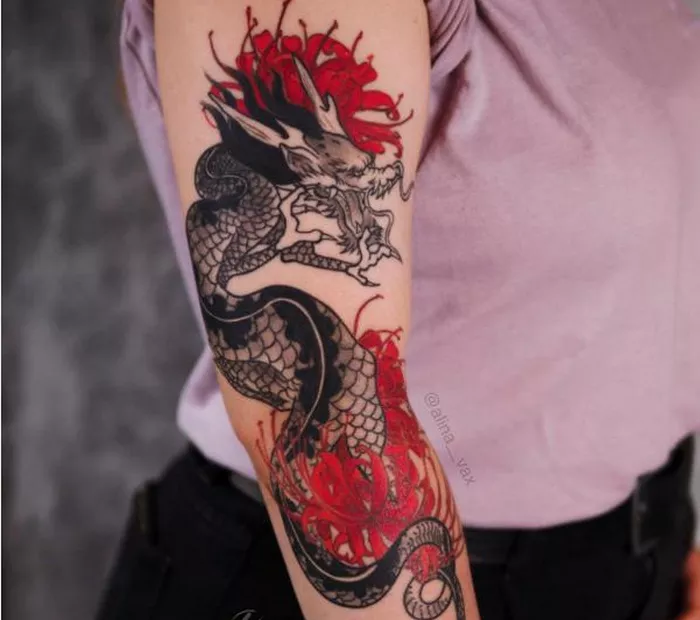Japanese dragon tattoos are among the most captivating and symbolic designs in tattoo artistry. Rooted deeply in Japanese mythology and culture, these dragons represent power, strength, and wisdom. Each design intricately weaves together elements that tell stories of ancient legends and spiritual beliefs. Whether you’re drawn to the bold lines of traditional irezumi or the contemporary interpretations of modern tattoo artists, Japanese dragon tattoos continue to fascinate and inspire tattoo enthusiasts worldwide.
1. Traditional Ryū Dragon
The traditional Japanese ryū dragon is a classic motif in tattoo artistry. Known for its serpentine body, clawed feet, and often depicted with a pearl or flaming pearl, the ryū symbolizes wisdom and protection. Artists often use bold lines and vibrant colors to bring out the dragon’s majestic presence.
2. Koi Dragon Transformation
A popular theme in Japanese tattooing is the koi dragon, where a koi fish transforms into a dragon after swimming upstream and leaping over the Dragon Gate waterfall. This design symbolizes perseverance, transformation, and achievement against all odds.
3. Hō-ō Dragon
Inspired by the mythical phoenix, the hō-ō dragon symbolizes rebirth, renewal, and immortality. This design combines elements of both the dragon and the phoenix, creating a powerful representation of life’s cycles and overcoming adversity.
4. Shishi Lion-Dog Dragon
The shishi lion-dog, often found in Japanese architecture and folklore, is a protective guardian against evil spirits. In tattoo art, the shishi dragon combines the dragon’s fierceness with the lion-dog’s protective qualities, making it a popular choice for those seeking strength and courage.
5. Water Dragon
Water dragons are often depicted as serpentine creatures surrounded by water elements such as waves, clouds, or rain. Symbolizing adaptability and fluidity, these tattoos capture the dragon’s mythical ability to control water and weather.
6. Cloud Dragon
Cloud dragons are celestial beings that dwell among the clouds, symbolizing power and transformation. These tattoos often feature swirling clouds and ethereal backgrounds, emphasizing the dragon’s divine presence and connection to the heavens.
7. Dragon and Cherry Blossoms
Combining the strength of the dragon with the delicate beauty of cherry blossoms creates a striking contrast in tattoo art. Cherry blossoms symbolize the fleeting nature of life and the beauty in transience, making this design both powerful and poignant.
8. Dragon and Samurai
Incorporating a dragon with a samurai warrior evokes themes of honor, loyalty, and martial prowess. These tattoos often depict the dragon as a guardian or ally to the samurai, symbolizing protection and strength in battle.
9. Dragon and Peony
Peonies represent wealth, prosperity, and good fortune in Japanese culture. When paired with a dragon, these tattoos symbolize power, abundance, and the rewards of hard work and dedication.
10. Dragon and Temple Gates
Temple gates or torii symbolize the threshold between the physical and spiritual worlds. When accompanied by a dragon, these tattoos represent spiritual protection, wisdom, and the journey towards enlightenment.
11. Dragon and Waves
Waves are symbols of life’s constant ebb and flow, and when paired with a dragon, they emphasize the dragon’s mastery over water and natural forces. These tattoos often depict the dragon riding or emerging from turbulent waves, symbolizing resilience and adaptability.
See Also: 15 Unique Dragon Tattoo Designs of 2024
12. Dragon and Geisha
Geishas embody grace, beauty, and artistic skill in Japanese culture. When depicted with a dragon, these tattoos symbolize a harmonious balance between strength and elegance, tradition and modernity.
13. Dragon and Kanji
Incorporating Japanese kanji characters with a dragon tattoo adds layers of meaning and symbolism. Kanji characters can represent virtues such as courage, wisdom, or love, enhancing the dragon’s significance in the wearer’s life.
14. Dragon and Sakura
Sakura, or cherry blossoms, symbolize the fleeting nature of life and the beauty found in impermanence. When combined with a dragon, these tattoos represent transformation, renewal, and embracing the cycles of life.
15. Dragon and Tiger
The dragon and tiger are symbolic opposites in Eastern mythology, representing yin and yang, balance, and harmony. When depicted together in a tattoo, they symbolize the complementary forces of strength and resilience, ambition and courage.
Conclusion
Japanese dragon tattoos are not merely designs inked on skin; they are powerful symbols deeply rooted in Japanese mythology, culture, and spirituality. Each tattoo design tells a unique story of strength, wisdom, protection, and transformation. Whether you choose a traditional motif or a modern interpretation, Japanese dragon tattoos continue to inspire awe and admiration, making them timeless choices for tattoo enthusiasts seeking both artistic beauty and profound meaning in their body art.

